Papers by Elock E Shikalepo
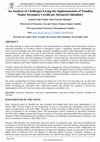
The study intended to explore the readiness of the implementation of Namibia Senior Secondary Cer... more The study intended to explore the readiness of the implementation of Namibia Senior Secondary Certificate Advanced Subsidiary in secondary schools in Ohangwena region. A qualitative research methodology was used, carried out through a case study design. Purposive sampling was used to select participants for the study. Questionnaires and interview were used as data collection methods. The collected data was analysed using thematic analysis. Key findings revealed that participants were unaware of the criteria's used to select the schools that shall offer Advanced Subsidiary Curricullum. Schools that offer Advanced Subsidiary seemed to have been selected based on assumptions such as human capital, availability of resources and infrastructures, teachers experience and former Namibia Senior Secondary School Certificate Higher level classification. Teachers experienced difficulties in implementing and managing the Advanced Subsidiary curriculum due to numerous factors such as late release of grade 11 Namibia Senior Secondary School Certificate Ordinary level results, lack of teaching and learning resources, dilapidated facilities, shortage of teachers who are experienced in teaching higher level subjects, complex and lengthy Advanced Subsidiary content that cannot be covered within the time frame allocated for instruction and assessment. The study concluded that curriculum planning and rolling out of the AS-Level curriculum was not done after proper consultations. If consultations were done, schools could have been provided with enough resources before introducing the curriculum. This would have ensured that schools were prepared to roll-out the implementation of the AS-Level curriculum with minimum to no hurdles at all.

Higher Education Institutions all over the world, have a greater role to play in addressing quali... more Higher Education Institutions all over the world, have a greater role to play in addressing quality in service delivery as well as anticipating client needs and satisfying them. To maintain quality and provide better service delivery to their stakeholders, many HEIs in Namibia have started to introduce quality management systems or quality assurance systems. This study intended to determine whether quality management processes in Namibian HEIs were implemented effectively, in compliance with international best practices. The study has used a mixed-methods research methodology, dominated mainly by quantitative research methods, with limited use of qualitative methods and data. Data was collected from a sample of 23 staff members and 74 final year students from one selected public HEI in Namibia. Findings from this study revealed that although quality management was being practiced at this institution, there was need to strengthen awareness among all the stakeholders, as well as maintain the active involvement of top management in quality management-related interventions. The study established that QMPs were not implemented effectively at both strategic, tactical and operational levels at the institutions, which then compromised the overall quality assurance of the institutions at different fronts. It was also established that serious attention should be given to monitoring and evaluation of implementation processes. Some stakeholders were also not made aware of QMPs at the institutions, which made stakeholders deficient in proving the required support towards the implementation of QMPs. The study recommends that HEIs should ensure that QMPs are implemented at all levels of the institutions. HEIs should sensitize all stakeholders to make them aware of the quality-assurance related policies and procedures that are in place and ensure that stakeholders are fully involved in their implementation, to realise effectiveness in the implementation of quality assurance practices in HEIs.
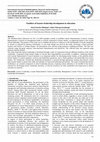
The Namibian Basic Education Act No 3 of 2020 mandates schools to establish Learner Representativ... more The Namibian Basic Education Act No 3 of 2020 mandates schools to establish Learner Representative Councils. Learner Representative Councils are management bodies at schools comprised of learner leaders, as supporting leaders to the overall school leadership. The purpose of the study was to establish the practices conducive to the development of learner leadership in schools as required by statutory instruments. A case study design was used for the study, involving a school principal, teachers and learners in Oshana Region. All participants were selected using purposive sampling technique. The data was collected using document analysis, semi-structured questionnaires and interviews. The collected data was analysed using thematic analysis method. The study found that learner leadership is developed through a spirit of cooperation between different members of the school community. Cooperation helps learner leaders to execute their responsibilities successfully. In addition, conducting meeting with Learner Representative Council members is an important enabler for developing learner leaders, as the platform allows learner leaders to express applause, concerns and leadership aspirations, and to obtain guidance and mentorship from senior leaders. The finding also revealed that leadership development is nurtured through appropriate training interventions vested upon learner leaders to groom their skills and attitudes for improved leadership performance. The study concluded that learner leadership is an essential component of school leadership structure, requiring school authorities to be mindful of the factors essential for developing learner leadership structures, so that the structures are fully established and empowered to deliver outcomes as expected.
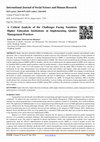
Higher education institutions (HEIs) in Namibia place a strong emphasis on quality assurance and ... more Higher education institutions (HEIs) in Namibia place a strong emphasis on quality assurance and standards in their operations. This is evident through the establishment of quality assurance units dedicated to the maintenance of high standards of education. Even though the significance of Quality Management Practices (QMPs) is acknowledged, Namibian HEIs encounter numerous challenges in hindering an effective implementation of QMPs. This study focused on identifying the challenges associated with the implementation of QMPs at HEIs in Namibia, with the aim of exploring how the implementation of QMPs can be improved for Namibian HEIs to produce quality graduates suited for market demand. A mixed-methods research methodology was employed for the study, where a total of 23 staff members and 74 final-year students from one public HEI in Namibia were selected as participants for the study. Questionnaires were distributed to both staff members and students, while staff members were also interviewed to gain a deeper understanding of the challenges related to the implementation of QMPs. Key findings revealed that the implementation of QMPs was faced by challenges related to inadequate human and financial resources, limited awareness about the benefits of quality management, poor communication and lack of collaborations within departments of HEIs, ineffective decision-making processes and inadequate training for staff members on QMPs. To mitigate these challenges, HEIs in Namibia should enhance their communication efforts with all stakeholders, increase staffing, and maximise training opportunities on QMPs. This will ensure an effective implementation of QMPs among HEIs, resulting in the production of graduates who are suited for the labour market.
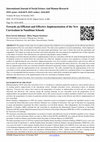
The purpose of this study was to explore measures that could best serve as prerequisites for the ... more The purpose of this study was to explore measures that could best serve as prerequisites for the efficient and effective implementation of the new curriculum in Namibian schools. The study used a qualitative research methodology, which employed a case study design. Semi structured interview and open-ended questionnaire were used to obtain data from the participants and respondents. The sample was made up of teachers and schools principals who were purposively sampled because of their typicality to the subject of research. The collected data was analysed using thematic analysis method. Key findings reveal that efficient and effective implementation of the new curriculum could best be achieved through the provision of adequate resources to schools before the curriculum was rolled out. Adequate resources were regarded as a measure of school readiness in implementing the new curriculum. Support programmes were also essential to equip teachers with necessary skills for them to meet the expectations of the new curriculum and enable them to discharge their duties effectively. The study also revealed that any implementation of the new curriculum should be informed by promising evidence of piloting, suggesting that a pilot study was needed to render the implementation of the curriculum effective. The study concluded that the implementation of the new curriculum in slowly gaining momentum due to various critical measures that needed to be considered before it was implemented. Thus, it is recommended that the measures as discussed in this article could still be considered and applied for improved operational efficiency and effectiveness of the implementation of the new curriculum in Namibian schools.
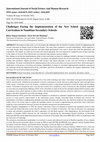
The purpose of this study was to investigate the challenges that are faced by secondary schools i... more The purpose of this study was to investigate the challenges that are faced by secondary schools in implementing the revised curriculum in Outapi Circuit of Omusati Region. The study used a qualitative research methodology, which employed a case study design. Semi structured interview and open-ended questionnaire were used to obtain data from the participants and respondents. The sample was made up of teachers and schools principals who were purposively sampled because of their typicality to the subject of research. The collected data was analysed using thematic analysis method. Key findings reveal that the implementation of the revised curriculum was faced by challenges related to shortages of instructional material and limited funding provisions, teachers' perceptions and attitudes towards the revised curriculum, as well as the lack of training and continuous support provisions to both teachers and school principals as they were not involved in curriculum development. The study concluded that the implementation of the revised curriculum was characterised by flaws which had negative implications on the process of teaching and learning. Stakeholders in charge of curriculum implementation should be cognisant of the challenges facing the implementation of the curriculum, and devise mechanisms to minimise the negative implications of the challenges for successful teaching and learning.
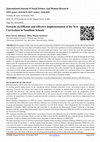
The purpose of this study was to explore measures that could best serve as prerequisites for the ... more The purpose of this study was to explore measures that could best serve as prerequisites for the efficient and effective implementation of the new curriculum in Namibian schools. The study used a qualitative research methodology, which employed a case study design. Semi structured interview and open-ended questionnaire were used to obtain data from the participants and respondents. The sample was made up of teachers and schools principals who were purposively sampled because of their typicality to the subject of research. The collected data was analysed using thematic analysis method. Key findings reveal that efficient and effective implementation of the new curriculum could best be achieved through the provision of adequate resources to schools before the curriculum was rolled out. Adequate resources were regarded as a measure of school readiness in implementing the new curriculum. Support programmes were also essential to equip teachers with necessary skills for them to meet the expectations of the new curriculum and enable them to discharge their duties effectively. The study also revealed that any implementation of the new curriculum should be informed by promising evidence of piloting, suggesting that a pilot study was needed to render the implementation of the curriculum effective. The study concluded that the implementation of the new curriculum in slowly gaining momentum due to various critical measures that needed to be considered before it was implemented. Thus, it is recommended that the measures as discussed in this article could still be considered and applied for improved operational efficiency and effectiveness of the implementation of the new curriculum in Namibian schools.
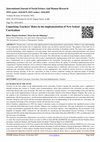
Teachers play a vital role in the implementation of educational policies and inventions. Without ... more Teachers play a vital role in the implementation of educational policies and inventions. Without a clear understanding of any programme that teachers have to implement, teachers may not deliver expected outcome. The purpose of this study was to examine the roles of teachers in the implementation of the school curriculum in Namibian schools. The study used a qualitative research methodology, which employed a case study design. Semi structured interview and open-ended questionnaire were used to obtain data from the participants and respondents. The sample was made up of teachers and schools principals who were purposively sampled because of their typicality to the subject of research. The collected data was analysed using thematic analysis method. Key findings reveal that teachers have key roles to play in facilitating the implementation of the new school curriculum. Teachers have a fundamental role to ensure quality implementation of the curriculum. Teachers play an important operational duty of implementing curriculum in the class, and without teachers' concerted efforts, the quality of curriculum implementation will be compromised. Teachers should also serve as effective collaborators during curriculum implementations. Teachers alone in their own classrooms could hardly implement curriculum effectively, requiring them to collaborate with each other's on how best they can implement the curriculum collectively. As teachers are key implementers, they should be actively involved in evaluating and assessing learning outcomes of the new curriculum, in order to inform continuous training for improved quality of learning outcomes. Teachers should be cognisant of the key roles that they have to play in ensuring an effective implementation of the new curriculum.
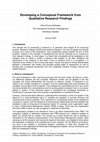
The ultimate aim of conducting a research is to generate new insights fit for improving practice.... more The ultimate aim of conducting a research is to generate new insights fit for improving practice. Research findings should bring positive changes in the lives of people and society at large. As a result of this expectation, many researchers always explain the aim of their research, relative to the changes or development that will be achieved as an outcome of their research findings. In most cases, it is heard that a framework will be developed or the research aims to create a model or advance new insights to the field. Whatever the significance of the research is and what it aims to advance once it is completed, it is important to be mindful of how to bring that about. Hence, this piece of writing differentiates between a framework and model, and provides guiding steps to researchers on how to develop their conceptual frameworks from their qualitative research findings, theories and related literature.

This paper discusses the revitalization of graduate employability in Namibia.
Namibia record 33.4... more This paper discusses the revitalization of graduate employability in Namibia.
Namibia record 33.4 % of 3644.11 of unemployed youth (ILO, 2019).
Namibian GRN adopted its NDP4 (2012/13 to 2016/17) and one of its goals is to create employment.
Every graduate aspire to become an active role player in the economic growth and sustainable development (Kadhila et al. 2020).
However, the majority of graduates struggles to secure employment (MHETI, 2021).
Institutions and industries have a responsibility of ensuring that graduates receive the required support they need to improve their employability.
Improving the employability of graduates is therefore a vital aspect for consideration by both universities and the industries (Kambonde, 2020; Aselebe, 2022).
The purpose of this paper was to analyse the employment opportunities of graduates after completing their tertiary education, with the aim of establishing the challenges facing graduate employability and advancing prospects for enhancing graduate employability.
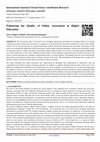
The devastating effect of Covid-19 have prompted educational practitioners to maximise efforts fo... more The devastating effect of Covid-19 have prompted educational practitioners to maximise efforts for ensuring continuous teaching, learning and assessment, by making use of instructional and assessment methods that do not involve human contact. The use of eLearning has since gained momentum, used for curriculum instruction and assessment. The purpose of this study was to establish the authenticity online assessment as used in higher education institutions, with the aim of advancing a model for ensuring an effective online assessment of curriculum content during and post-Covid-19 era. A desktop research methodology was used to gather data for the study. Published research articles on the challenges and effectiveness of online assessment were traced, reviewed and analysed according to predetermined topics of research interests. The findings from the review informed the themes that were interpreted and discussed as ultimate answers for the study. The interpretation of the themes draws insights from literature evidence and current observations in the field of online assessment.
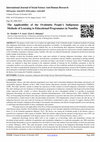
The purpose of this study was to explore the applicability of the Ovahimba people's traditional m... more The purpose of this study was to explore the applicability of the Ovahimba people's traditional methods of learning their Indigenous Knowledge Systems to educational programmes in Namibia. An ethnographic study was carried out within the Ovahimba community to explore the various methods they use in disseminating their indigenous knowledge systems among themselves. The data was collected through individual interviews and focus group interviews discussions with the sampled members of the Ovahimba community in Kunene region, Namibia. The data was analysed thematically, interpreted and discussed drawing further insights from literature evidence. Key findings revealed that Ovahimba people have eight main methods of learning indigenous knowledge, which relates to observations, practical learning, show-and-teach, demonstration, consultation, dancing, folktales, questioning or probing methods, and incidental learning. Educational institutions, curriculum developers and teachers in Kunene region where Ovahimba people resides, are implored to align their teaching to the traditional methods of learning for the Ovahimba community so that the community members can easily grasp the curriculum content as those are their traditional methods of learning that are familiar to them. The study recommended the integration of the methods into the educational programmes meant for the Ovahimba community. Such integration would help Ovahimba people to relate their learning to their indigenous methods of knowing, ultimately enhancing the literacy level among the Ovahimba community.
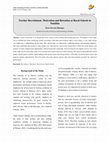
The European Educational Researcher, 2019
Teacher motivation is an integral part of the success of the teaching and learning processes. The... more Teacher motivation is an integral part of the success of the teaching and learning processes. The purpose of this study was to establish the factors underlying teacher recruitment, motivation and retention within a rural context. A case study design was employed as a methodology for the study. The collected data was analysed by establishing themes and emerging categories. The study established that teachers at rural schools were motivated by crucial work-related factors which were both intrinsic and extrinsic in nature. Employment opportunities, family background, leadership, rural environment and support services were some of the major factors motivating teacher to be recruited and retained with rural school teaching. The study recommended that school leaders should acquire a holistic understanding of the diverse factors motivating teachers, so that they can nurture these factors and motivate teachers appropriately. This will ensure that rural schools remains with motivated teaching personnel for improved performance.
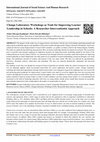
International Journal of Social Science and Human Research, 2021
The purpose of this study was to engage learners and teachers with the aim of developing leadersh... more The purpose of this study was to engage learners and teachers with the aim of developing leadership potential and improving the leadership capacity and capabilities of the learner leaders through mainly Change Laboratory Workshops, which were conducted with the Learner Representative Council (LRC) members, at a public secondary school in the Oshana Region, Namibia. The study was guided by the following main question: How can learner leadership structure be improved in schools? The researchers used a researcher-interventionist approach to implement measures for improving learner leadership, guided by the ideals of the Cultural Historical Activity Theory (CHAT), as a theoretical lens through which the researchers made interventions for improving learner leadership at school. Empirically, the study made use of a qualitative research methodology carried out through a case study design. The population consisted of teachers and learners of the case study school. The data was collected by ...
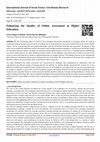
The devastating effect of Covid-19 have prompted educational practitioners to maximise efforts fo... more The devastating effect of Covid-19 have prompted educational practitioners to maximise efforts for ensuring continuous teaching, learning and assessment, by making use of instructional and assessment methods that do not involve human contact. The use of eLearning has since gained momentum, used for curriculum instruction and assessment. The purpose of this study was to establish the authenticity online assessment as used in higher education institutions, with the aim of advancing a model for ensuring an effective online assessment of curriculum content during and post-Covid-19 era. A desktop research methodology was used to gather data for the study. Published research articles on the challenges and effectiveness of online assessment were
traced, reviewed and analysed according to predetermined topics of research interests. The findings from the review informed the
themes that were interpreted and discussed as ultimate answers for the study. The interpretation of the themes draws insights from
literature evidence and current observations in the field of online assessment.
The study established that online assessment was characterised by challenges that compromised its authenticity, thus not
contributing to the effective mastery of learning outcomes by students. As students attempt assessment tasks on their own, it was
difficult to establish if the submitted work was indeed their own or not. In addition, assessment tasks were too many and impractical
for students to handle in a given time. Covid-19 pandemic requires that higher education institutions consider employing online
instruction and assessment. However, online assessment methods should be authentic in design and implementation to reflect good
quality teaching and learning. The study recommends that higher educational institutions should use online assessment methods that
enhance objective and credible assessment such as administering synchronous activities and by customising assessment tasks for
students.
KEYWORDS: Online assessment, Authentic assessment, eLearning, Covid-19, Higher education.
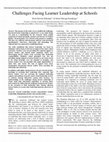
International Journal of Research and Innovation in Social Science, 2021
The purpose of the study was to establish the challenges that faced learner leadership at school ... more The purpose of the study was to establish the challenges that faced learner leadership at school level. A case study design was used as a methodology for the research, whose sample comprised of school principals, teachers and learners of Oshana Region. All participants were selected using purposive sampling. The data was collected with document analysis, semi-structured questionnaires, interviews, observation and journaling. The collected data was analysed by establishing themes. The study established that learner leadership was faced by challenges which relates to the lack of support from senior school structures. Teachers were not providing the required support to learner leaders, and instead made comments which were discouraging learner leaders from executing their leadership responsibilities. Similarly, school principals were also not providing enough support to learner leaders as any issues raised to the school principal were not attended to promptly, and learner leaders were not provided with ample opportunities to make their voice heard. The lack of support from senior management discouraged learner leaders from executing the leadership roles effectively. In addition, indiscipline among learners also gave learner leaders hardships in executing their leadership roles, especially that learner leaders were not receiving the required leadership support and guidance from the senior school leadership on how to conform unusual behaviours among other learners. An understanding of the challenges facing learner leadership at school could help educational authorities to develop better interventions for addressing the challenges facing learner leaders in the execution of their leadership roles, thereby allowing learner leaders to execute their leadership functions effectively at school.
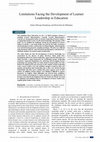
The Namibian Basic Education Act No. 3 of 2020 mandates schools to establish Learner Representati... more The Namibian Basic Education Act No. 3 of 2020 mandates schools to establish Learner Representative Councils. Learner Representative Councils are management bodies at schools comprising of learner leaders, as supporting leaders to the overall school leadership. The purpose of the study was to establish the challenges facing the development of learner leaders in schools. A case study design was used for the study, involving a school principal, teachers, and learners in Oshana Region. All participants were selected using purposive sampling technique. The data was collected using document analysis, semi-structured questionnaires, and interviews. Thematic analysis was used to analyse textual data. The study found out that the development of learner leadership was constrained by the absence of policy directives which could drive development efforts for learner leadership. Apart from the Education Act which provides a legal framework for establishing learner leadership structures, importa...
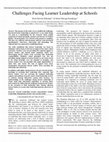
The purpose of the study was to establish the challenges that faced learner leadership at school ... more The purpose of the study was to establish the challenges that faced learner leadership at school level. A case study design was used as a methodology for the research, whose sample comprised of school principals, teachers and learners of Oshana Region. All participants were selected using purposive sampling. The data was collected with document analysis, semi-structured questionnaires, interviews, observation and journaling. The collected data was analysed by establishing themes. The study established that learner leadership was faced by challenges which relates to the lack of support from senior school structures. Teachers were not providing the required support to learner leaders, and instead made comments which were discouraging learner leaders from executing their leadership responsibilities. Similarly, school principals were also not providing enough support to learner leaders as any issues raised to the school principal were not attended to promptly, and learner leaders were not provided with ample opportunities to make their voice heard. The lack of support from senior management discouraged learner leaders from executing the leadership roles effectively. In addition, indiscipline among learners also gave learner leaders hardships in executing their leadership roles, especially that learner leaders were not receiving the required leadership support and guidance from the senior school leadership on how to conform unusual behaviours among other learners. An understanding of the challenges facing learner leadership at school could help educational authorities to develop better interventions for addressing the challenges facing learner leaders in the execution of their leadership roles, thereby allowing learner leaders to execute their leadership functions effectively at school.










Uploads
Papers by Elock E Shikalepo
Namibia record 33.4 % of 3644.11 of unemployed youth (ILO, 2019).
Namibian GRN adopted its NDP4 (2012/13 to 2016/17) and one of its goals is to create employment.
Every graduate aspire to become an active role player in the economic growth and sustainable development (Kadhila et al. 2020).
However, the majority of graduates struggles to secure employment (MHETI, 2021).
Institutions and industries have a responsibility of ensuring that graduates receive the required support they need to improve their employability.
Improving the employability of graduates is therefore a vital aspect for consideration by both universities and the industries (Kambonde, 2020; Aselebe, 2022).
The purpose of this paper was to analyse the employment opportunities of graduates after completing their tertiary education, with the aim of establishing the challenges facing graduate employability and advancing prospects for enhancing graduate employability.
traced, reviewed and analysed according to predetermined topics of research interests. The findings from the review informed the
themes that were interpreted and discussed as ultimate answers for the study. The interpretation of the themes draws insights from
literature evidence and current observations in the field of online assessment.
The study established that online assessment was characterised by challenges that compromised its authenticity, thus not
contributing to the effective mastery of learning outcomes by students. As students attempt assessment tasks on their own, it was
difficult to establish if the submitted work was indeed their own or not. In addition, assessment tasks were too many and impractical
for students to handle in a given time. Covid-19 pandemic requires that higher education institutions consider employing online
instruction and assessment. However, online assessment methods should be authentic in design and implementation to reflect good
quality teaching and learning. The study recommends that higher educational institutions should use online assessment methods that
enhance objective and credible assessment such as administering synchronous activities and by customising assessment tasks for
students.
KEYWORDS: Online assessment, Authentic assessment, eLearning, Covid-19, Higher education.
Namibia record 33.4 % of 3644.11 of unemployed youth (ILO, 2019).
Namibian GRN adopted its NDP4 (2012/13 to 2016/17) and one of its goals is to create employment.
Every graduate aspire to become an active role player in the economic growth and sustainable development (Kadhila et al. 2020).
However, the majority of graduates struggles to secure employment (MHETI, 2021).
Institutions and industries have a responsibility of ensuring that graduates receive the required support they need to improve their employability.
Improving the employability of graduates is therefore a vital aspect for consideration by both universities and the industries (Kambonde, 2020; Aselebe, 2022).
The purpose of this paper was to analyse the employment opportunities of graduates after completing their tertiary education, with the aim of establishing the challenges facing graduate employability and advancing prospects for enhancing graduate employability.
traced, reviewed and analysed according to predetermined topics of research interests. The findings from the review informed the
themes that were interpreted and discussed as ultimate answers for the study. The interpretation of the themes draws insights from
literature evidence and current observations in the field of online assessment.
The study established that online assessment was characterised by challenges that compromised its authenticity, thus not
contributing to the effective mastery of learning outcomes by students. As students attempt assessment tasks on their own, it was
difficult to establish if the submitted work was indeed their own or not. In addition, assessment tasks were too many and impractical
for students to handle in a given time. Covid-19 pandemic requires that higher education institutions consider employing online
instruction and assessment. However, online assessment methods should be authentic in design and implementation to reflect good
quality teaching and learning. The study recommends that higher educational institutions should use online assessment methods that
enhance objective and credible assessment such as administering synchronous activities and by customising assessment tasks for
students.
KEYWORDS: Online assessment, Authentic assessment, eLearning, Covid-19, Higher education.
Recently, all three still remain essential expectations, with research as the top priority in most higher education institutions (Boyce & Aguilera, 2021).
There has been increasing pressure to improve the quality of postgraduate research in higher education through more intensive research undertaking and supervision, accompanied by arguments for creating research-intensive universities (Masterman, 2016).
A research-intensive university (RIU) is a higher learning institution where the quantum of teaching is less than that of research conducted at the university. Most universities are migrating from being teaching-based universities to RIUs, and the aspiration to conduct cutting-edge research is maximised to position universities as market leaders in knowledge creation, and inform the provision of teaching for their students.
The benefit of studying at a RIU is that it allows students to be taught by lecturers that are at the forefront of their fields.
Furthermore, it is beneficial to students in a sense that students are taught by leading academics who are at the same time conducting exciting research as well as teaching them which provides exciting opportunities to be taught by highly commendable academics.
Finally, a degree from a research-intensive university has international recognition due to the world-renowned reputations and rankings of the institutions.
Prospective employers and graduate academic programs will search for students from these institutions due to the high-quality education they are provided.
Despite society’s expectations of higher education institutions to serve as the driver of new innovations, the contribution of higher education to the generation of new ideas and knowledge falls short of expectations (Taylor, 2019).
Hence, there is a need to maximise the potential of postgraduate research in higher education to generate new knowledge.
Therefore, this study explored ways that universities can consider as baselines for turning into RIUs that are capable of meeting the expectation of new knowledge creation.
Many people are starting to upgrade their undergraduate qualifications by enrolling in various postgraduate programs (De Villiers, 2019).
Postgraduate studies can be very intensive and demanding, especially given the target market it serves.
The throughput of postgraduate enrolment is often faced with delays. Despite these delays, postgraduate studies should be completed on schedule to generate new knowledge and grow economies (Sondlo, 2016). This study explored the challenges facing students in their postgraduate studies and suggested factors that could improve the throughput rate of postgraduate students in Namibian higher education institutions.
Academic programs are continually upgraded to remain competitive and relevant with the inclusion of research modules taking a centered stage.
There has been an increase in enrollment in postgraduate programs where research is a key component toward successful completion (Mavundla, 2021). Karunaratne (2018) and; Amani, Myeya, and Mhewa (2022) argue that a constant increase of students entering higher education possess a challenge for many higher educational institutions to maintain quality. An increase in enrollment equates to an increased workload in Postgraduate research supervision.
Consequently, an increase in supervision workload requires contemporary ways of supervision to cope with the demand (Karunaratne,2018).
There is a need to improve supervision of higher degree students to increase completion rates, reduce attrition and improve quality (Maor, 2015)
Countries such as Finland, have already embraced the contemporary ways by adopting a digitalized model (EXOD) for the digitalization of university processes for e-supervision called Wihi, (Lindstedt, Lagstedt & Kauppinen,2021). While countries such as Uganda use SciPro support systems for its e supervision (Hansen and Hansson 2015; Karunaratne 2018).
E-Supervision is the electronic research supervision platform for facilitating interaction between supervisors and supervisee and other parties to the research process such as moderators and examiners (Bakar, Isa, Sani, & Shahbudin (2015).
Maor (2015) supports that using technology as a tool in supervision transforms the character of higher-degree training and raises the research outcomes for Australian universities.
Of recent a new online platform was launched to assist 225,000 TVET students in keeping up with their studies in Ukraine despite the war. (ILO,2022).
Despite the global acceptability, the significance of online learning, and an increase in online courses the quality of online learning graduates have not been attractive and convincing to employers, that's hesitant to absorb them into the labor market.
Canon (2022) and Falode et al,( 2021) support that the employability of a graduate with an online degree has not kept pace with the growth of this delivery method.
Hence, it is vital to ensure that the human capital within higher education institutions is well nurtured to render effective production of graduates who are highly qualified, fit for purpose and steer the sustainable development agenda.
Higher education institutions have an important role to play in developing their human capital for improved quality graduates.
To meet this expectation, higher education institutions needs to demonstrate a high level of quality research output, quality teaching and quality graduates who possess requisite skills, knowledge and attitudes required by the job market.
Higher education institutions should actualize innovative and viable instructional methods in preparing both undergraduates and postgraduates students in succeeding with their learning.
KEYWORDS:
Learner leadership, Learner representative council, Leadership, Management, learner voice, learner leader, Cultural Historical Activity Theory (CHAT), Change Laboratory Workshop (CLW), Researcher-Interventionist Approach
Curricula should not only seek to equip trainees with occupational skills and attitudes to seek employment, but also with entrepreneurial capabilities for turning their occupational skills into feasible, viable and sustainable industrial entities. Therefore, TVET institutions should map out an appropriate model for ensuring successful integration of entrepreneurial education at every stage of the vocational education, to subsequently graduate committed and skilled artisans who are business-minded.
As an outcome, this presentation endeavours to explain a model whose implementation could realise sustainable entrepreneurship and innovation among TVET graduates.
Keywords: entrepreneurship, entrepreneur, innovation, sustainability, TVET.
The presentation of the content in the book is predominantly qualitative in design, departing from the social science school of thought. However, research is a three-legged pot, anchored on three perspectives; qualitative, quantitative and mixed-methods perspectives. Even though the book is underpinned by a qualitative perspective, quantitative and mixed-methods perspectives have also been cited in the book. It is rarely common for a research book to stand purely on a single perspective without the supporting legs of the other two perspectives. Therefore, throughout the different chapters of the book, direct and indirect references have been made to quantitative and mixed-methods perspectives, though not considerably.
The purpose of this study was to evaluate the effectiveness of the financial incentive on the performance of learners at rural schools, as this performance relates to teacher motivation. To achieve this, a literature study and an empirical investigation were conducted. An interpretivist research paradigm informed the methodology for the study. A mixed-methods research approach, which relied more on a qualitative research design, included a research sample of 28 teachers, five school principals and two education officials. Data were collected through interviews and document analysis. Individual interviews were conducted with education officials and school principals. Focus group interviews were conducted with teachers. Document analysis entailed accessing applicable documents of each research site in the office of the school principal. Textual data were analysed and presented thematically and numeric data were analysed and presented as frequencies and percentages.
Key findings established that financial incentive has contributed little to the performance of learners in rural schools. The fact that rural schools are not properly categorised according to environmental challenges results in teachers not receiving realistic financial incentive. Teachers were therefore not motivated by financial incentive, but by other factors relating to being tuned to nature in rural areas, being exposed to lower living costs and enjoying accommodating school leadership and community care. A revisiting of the implementation of the financial incentive is recommended in order to negate shortcomings and enhance the potential of financial incentive to contribute to improved learner performance as steered by motivated teachers.
There are students who continue to miss out on graduation lists of different tertiary institutions for having outstanding research projects. It is either the research project is not conducted or the research report is not submitted for examination. In most cases, such students have completed coursework modules including the theoretical research component. Supposedly, the impression is that there is a gap between supervisors and supervisees that prevents the two parties from finding each other and see through the completion of the research conduct and final reporting. Thus, this article reflects on current supervision of research in institutions of higher educations, and sheds light on the individual roles of both the supervisors and supervisees, as well as their collective role, with the hope that refreshing an understanding of individual and mutual roles may help maximising the effectiveness of research conduct by students and research supervision by supervisors, a necessary ingredient for completing study programmes on schedule.
Online learning has been shown to support the continuation of teaching and learning during emergencies such as during the COVID-19 Pandemic.
Of recent a new online platform was launched to assist 225,000 TVET students in keeping up with their studies in Ukraine despite the war. (ILO,2022).
Despite the global acceptability, the significance of online learning, and an increase in online courses the quality of online learning graduates have not been attractive and convincing to employers, that's hesitant to absorb them into the labor market.
Canon (2022) and Falode et al,( 2021) support that the employability of a graduate with an online degree has not kept pace with the growth of this delivery method.